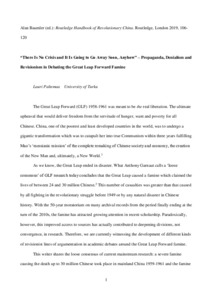There Is No Crisis and It Is Going to Go Away Soon, Anyhow” – Propaganda, Denialism and Revisionism in Debating the Great Leap Forward Famine
Lauri Paltemaa
https://urn.fi/URN:NBN:fi-fe2021042821038
Tiivistelmä
The Great Leap Forward (GLF) 1958–61 was meant to be the real liberation. The ultimate upheaval that would deliver freedom from the servitude of hunger, want and poverty for all Chinese. China, one of the poorest and least developed countries in the world, was to undergo a gigantic transformation which was to catapult her into true communism within three years, fulfilling Mao’s “messianic mission” of the complete remaking of Chinese society and economy, the creation of the New Man and, ultimately, a New World.1
As we know, the Great Leap ended in disaster. What Anthony Garnaut calls a “loose consensus” of GLF research today concludes that the Great Leap caused a famine which claimed the lives of between 24 and 30 million Chinese.2 This number of casualties was greater than that caused by all the fighting in the revolutionary struggle before 1949 or by any natural disaster in Chinese history. With the 50-year moratorium on many archival records from the period finally ending at the turn of the 2010s, the famine has attracted growing attention in recent scholarship. Paradoxically, however, this improved access to sources has actually contributed to deepening divisions, not convergence, in research. Therefore, we are currently witnessing the development of different kinds of revisionist lines of argumentation in academic debates around the Great Leap Forward famine.
This writer shares the loose consensus of current mainstream research: a severe famine causing the death up to 30 million Chinese took place in mainland China 1959–61 and the famine was largely man-made, caused by the Great Leap policies and the way the Maoist regime reacted to the famine. However, this chapter does not try to explain the causes of the famine or address the issue of culpability as such. Instead, it outlines the development of GLF famine studies and tries to put revisionism into historical perspective by comparing it with the little-studied way that official propaganda managed popular sentiments throughout the campaign. It is argued here that in many ways denialist revisionism signifies a return to the obfuscation of facts which propaganda used during the famine.
Kokoelmat
- Rinnakkaistallenteet [27094]
